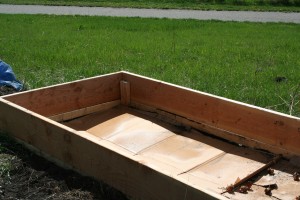How to Create a Lasagna Garden

Lasagna gardening is a no-till method of creating a garden bed over an area of grass or weeds. While many people start lasagna gardens in the fall so the garden can cook over the winter, these gardens can be created anytime the soil is bare.
The basic idea of a lasagna garden is that you layer materials (some of which would normally go in the compost pile) to create your garden bed. Like lasagna, the garden has several types of layers and, after it cooks, the layers shrink and blend into each other. The method requires only a little time, some cardboard and compost, and lots of water.
Step one is to decide where you want the garden to be and what shape it will take. You can use a hose on the ground to tweak the shape of your new garden. When you are satisfied with how it will look, mow the area very short, if there is grass on it. Wet the area down. Remember the key to lasagna gardening is lots of water!
Next put down a layer of cardboard or six to 10 layers of newsprint. (Do not use the shiny sections of the paper; they have chemicals in them you do not want in your soil.) If you use newspaper, make sure the layers overlap each other and wet it down as you go. For cardboard, place the sections close together and put down several layers of newsprint between each section. You want to thoroughly smother whatever is growing underneath your cardboard or newsprint layer. Wet everything as you go.

Next layer on the compost: You can use finished or partially finished compost from your own pile or compost from a city site. In fall, you could also layer on leaves, grass clippings, spent perennials and any other garden material that is not diseased. In between layers of unfinished compost, add finished compost or black dirt. Keep wetting things down. You want a minimum of 5 to 6 inches of compost layers on top of your newsprint/cardboard layer. Again, wet it down. On top of the compost layers, add a layer of finished compost or packaged garden soil. Wet that down.

For an ornamental bed, you may want to add mulch to the top, such as shredded leaves or bark chips. Now, let the garden sit. In a few months, you will have rich soil.
If you are the impatient type (ahem, some of us just are), you could layer a bit more compost on the top layer and plant the garden out almost immediately.

3 Comments
-
Pingback: Bleeding Heartland
-
Pingback: Building Raised Bed Gardens: 2 Basic Options - Minnesota State Horticultural Society
-
Pingback: Building Raised Bed Gardens: 2 Basic Options - Minnesota State Horticultural Society
Back to Blog